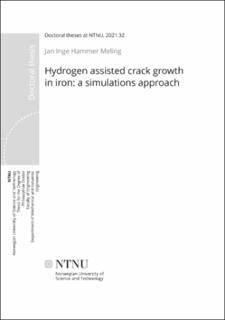| dc.description.abstract | Hydrogen enhances crack growth, limiting the lifetime of industrial components. Despite the abundance of research into hydrogen enhanced crack growth and its proposed mechanisms, none of the models can explain all the observations.
The effect of hydrogen on the growth of a sharp crack in a Fe-3wt%Si is an enhanced crack growth rate and a sharper crack. The higher the hydrogen gas pressure, the sharper the crack tip. Other observations include a reduced residual plastic zone. The objective of this thesis is to investigate how hydrogen may cause the enhanced crack growth rate and crack sharpening by implementing variants of the hydrogen mechanism HEDE and HELP.
In this work, we show that hydrogen can activate mechanisms suggested by the literature, and the deciding factor is system-specific. Two different simulation models are used to investigate the hydrogen effect. The first is a study on a sharp crack simulated using 2D discrete dislocation dynamics. In the case of a sharp crack tip in Fe-3wt%Si, a reduction in the cohesive energy at the crack tip is the most critical for the crack growth and sharpening of the crack. The second study is a time-dependent microstructure evolution model of nanoindentation. In the case of nanoindentation, the reduction in the line energy of dislocations is the most prominent hydrogen effect.
Both models emulate the hydrogen mechanisms through the defactant framework. The defactant framework describes the hydrogen influence as a reduction in the energy of defects as a function of the chemical potential of hydrogen. The hydrogen effect of reducing the line energy of dislocations does not replicate the sharpening of the crack. A reduction in the cohesive force, on the other hand, does. A lowered cleavage criterion due to decohesion at the crack tip results in less plasticity before a cleavage event. Activation of a cleavage event at a lower load replicates the experimental findings of lowered fracture toughness, enhanced crack growth rate and a sharper crack tip. However, this does not rule out the hydrogen effect on dislocations, as that hydrogen effect replicates the lowered pop-in seen in nanoindentation experiments.
Hydrogen can promote several fracture types; intergranular, transgranular or void growth and coalescence. Which fracture type hydrogen promotes, depends on the loading conditions, charging conditions and the underlying microstructure. Hydrogen promotes local deformation where it accumulates, and different loading and charging conditions can change where and at what rate hydrogen is accumulating. The hydrogen effect should be linked to the charging conditions using the chemical potential of hydrogen. We suggest the best way forward is to assume the hydrogen effect is a hybrid of several mechanisms, and which is critical depends on the system. | en_US |
